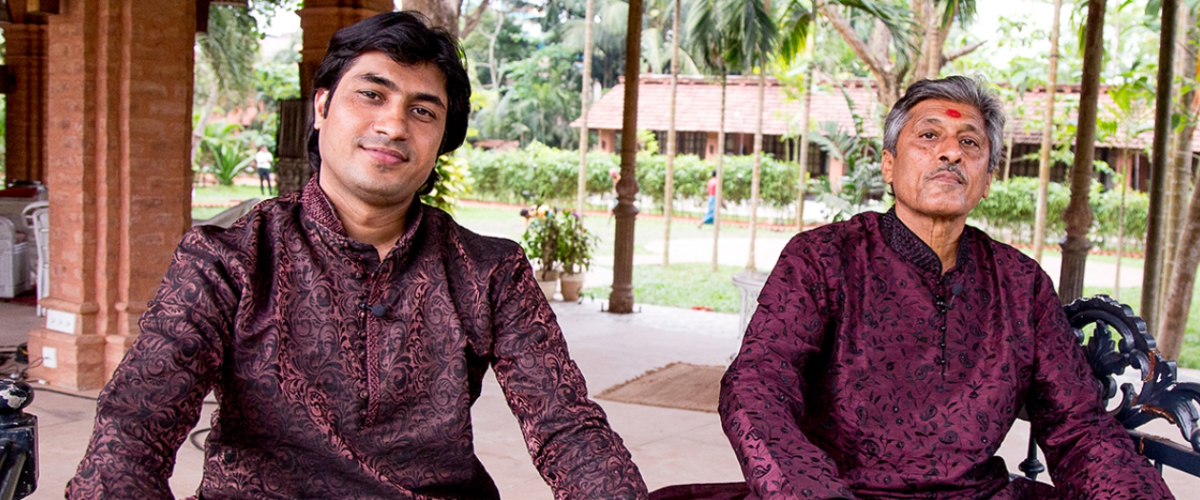

Individual expression is highly valued in an artist, and this is no different within the context of Indian classical music. But whilst being allowed to develop a personal style, the Indian music tradition is firmly rooted in the idea of guru-shishya - referring to the relationship between the master and student. Traditionally, extended (often lifelong) close contact with the master meant that their personal style was firmly imprinted on the student. The Northern Hindustani and Southern Carnatic traditions take slightly different approaches to this idea.
Most Hindustani musicians train under the umbrella of a certain style, known as a gharana. The word means family, and is derived from the Urdu for ‘house’. In the context of music, it refers to a musical lineage with a consistent and special approach to presentation. Within a fashion house, different designers may create and innovate various styles of garment, but according to their training and the house style, their work normally has recognisable stylistic link with their fashion origins. Just as connoisseurs of fashion can distinguish Chanel from Prada, an experienced listener can quite quickly pick out the salient features that identify one gharana from another.
A gharana can be named after a person or family, as in the Senia gharana (named for saint-musician Tansen), or a place, as in the Gwalior or Jaipur gharanas. But before you get any ideas, a gharana can’t be created on a whim. If you wanted to create your own, you would have to first give existing structures a totally new approach, form and interpretation, including the intonation and inflections of the voice and the specific application of various ornamental nuances.
You would then have to get busy establishing three generations of teachers and students who are all deemed to be training and performing at a high standard. After three generations, this group may be considered a gharana. There are gharanas for vocal styles like thumri and khayal, as well as for instrumental music and dance.
The present gharana system is not so old, but became more prominent in the 18th and 19th centuries. Before the ease of modern travel and communication, musicians from a certain region would hardly be exposed to anything but what was around them, especially if they were employed exclusively in the service of a rich patron.
Sometimes the princes and noblemen of both the Mughal period and the newly rich who emerged after the end of their reign would hold soirees, where musicians of different gharanas would present their music. Naturally, musicians would become influenced after hearing different ragas and styles of presentation often inspiring them to reinterpret the material through the lens of their own style.
If Hindustani music has been a free-flowing river, incorporating tributaries and sprouting streams, Carnatic music has been more of a mountain range, with some exponents even claiming that there have been few changes since the musical system was handed to people by the gods.
Teachers and performers have endeavoured to carefully guard this purity and the fact that cultural and language barriers separated it from the North helped this isolation. It has never become as internationally well known as Hindustani music and exponents are sometimes even accused of being unnecessarily staid and stubborn to move with the times.
Whilst disciples are undeniably linked to their lineage through the chain of guru-shishya sampradaya, and these varying styles are inevitably compared, the concept of gharana is not emphasised. Some musicians, such as the innovative violinist Lalgudi Jayaraman, have created a signature style, known as a bani (in his case, Lalgudi bani), which is imbibed and carried on by their students. However, it is expected that every serious musician will to some degree develop their own bani, whilst remaining faithful to the highly complex and structured forms of Carnatic music.
Today the gharana system is losing its relevance. In an era where audio recording was not possible and musical notation was unsophisticated, it helped to preserve rich bodies of musical material and to facilitate high quality training. However, contemporary students have unlimited access to diverse concerts and audio recordings and their training is often conducted under more than one teacher.
Therefore, the kind of isolation that helped gurus in the medieval period to conserve their particular tradition is very difficult to recreate. Though the digital age has created new, dynamic opportunities for international cross-pollination, it remains to be seen whether this will still encourage distinct styles to be nurtured and carried forward.
Listen to the music | Bansuri master Pandit Rajendra Prasanna performs with his son and student Rishab at Darbar Festival 2012.
Jahnavi Harrison is a multi-disciplinary artist, specialising in vocal music, Kirtan meditation, and Indian devotional dance.
Darbar believes in the power of Indian classical music to stir, thrill, and inspire. Explore our YouTube channel, or subscribe to the Darbar Concert Hall to watch extended festival performances, talk and documentaries in pristine HD and UHD quality.
One famous story of an Indian musician tuning before his audience has now taken a permanent place in the annals of...
Read More 
Born in 1861 in Calcutta (now called Kolkata), Rabindranath Tagore was the most outstanding polymath of his age.
Read More 
Apart from musical content and the esoteric concept of rasa ('juice, essence, flavour') Indian classical raags...
Read More 
The beginner's guide to Indian classical music. Whether you’re completely new to raga music or just need a refresher, we’ve put together this brief overview of all things raga music to help you feel at ease when visiting one of our concerts or watch our videos on our YouTube or our Darbar Concert Hall.

Keep up to date with the latest news, events, music and musings across our social channels
For hundreds more clips and shorts, vist our YT page here 
Be the first to hear before events go on sale. Get the latest news and articles from Darbar